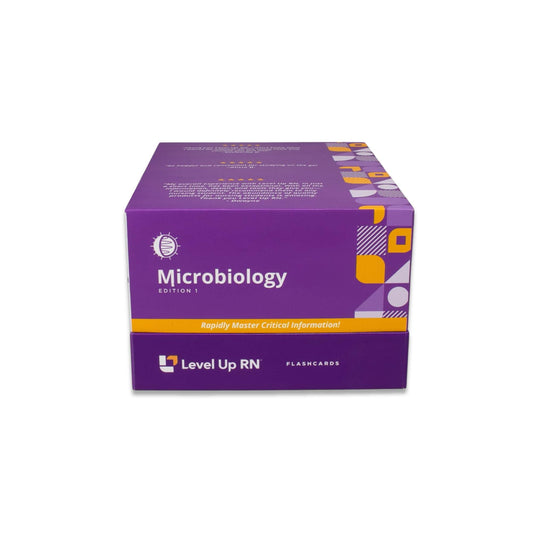Hi, I'm Cathy with Level Up RN. In this video, I will be discussing how to prepare a specimen for light microscopy, and I will also be discussing common dyes and stains used in microbiology. At the end of the video, I'm going to give you guys a quiz to test your understanding of some of the key facts I'll be covering. So definitely stay tuned for that. And if you have our Level Up RN Microbiology flashcards, go ahead and pull out your flashcards so you can follow along with me, and pay close attention to the bold red text on the back of the cards because those are the things that you are likely to get tested on.
Before we can observe a specimen using a bright-field microscope, we need to first prepare the specimen using wet mount or fixation. With wet mount, the specimen is placed on the slide in a drop of liquid. If the specimen is already in liquid format, such as urine, you can just place the specimen on the slide using a dropper. And then afterwards, we would put a cover slip over the specimen. The other method for preparing a specimen is fixation, which is the process of fixing or attaching the cells to a slide using heat or chemicals. Of note, fixation does kill the microorganisms in the specimen. So first, we need to create a smear. This is where we spread a thin layer of the specimen on a slide, and we allow the slide to air dry. Then with heat fixation, we would briefly heat the slide over a heat source, such as a Bunsen burner. With chemical fixation, the specimen is treated with a chemical agent, such as formaldehyde or ethanol.
Once we have prepared our specimen using fixation, we are ready to stain our specimen using dyes to make it more visible when we view it with a bright-field microscope. So there are two types of dyes. We have a basic dye and an acidic dye. A basic dye is a positive stain that is attracted to the negatively charged cells in the organisms that we will be observing. So those organisms are going to absorb the dye. So a basic dye is going to stain the cells. Examples of basic dyes include crystal violet, methylene blue, and safranin. On the other hand, an acidic dye is a negative stain, so it will be repelled by the negatively charged cells, so the cells will not take up the dye. And instead, the background will be stained. An example of an acidic dye is Congo Red.
Staining techniques include simple staining and differential staining. A simple stain uses a single dye and is used to visualize the size, shape, and arrangement of cells. However, with a simple stain, you cannot differentiate between different organisms within a specimen. For that, you need a differential stain, which uses multiple dyes and allows you to differentiate between those different organisms in a sample. It also lets you visualize different structures or components within a single organism. Examples of differential stains include the gram stain, acid-fast stain, capsule stain, endospore stain, and flagella stain.
Let's now go into a little more detail about each of these differential staining techniques. And in my next video, I will go into a lot more detail about several of these techniques. So a gram stain is used to differentiate bacteria based on their cell wall type. So it will differentiate between gram-positive and gram-negative bacteria. An acid-fast stain is used to differentiate bacteria that have mycolic acid in their cell wall, such as mycobacterium tuberculosis, which is shown here. An endospore stain is used to visualize endospores, which are structures within bacterial cells that allow for survival in harsh conditions. A capsule stain is used to identify bacteria that have a capsule. So that's a protective outer structure on the cell that allows for protection as well as adherence to surfaces and evasion of the immune system. And then a flagella stain allows for visualization of flagella, which are long whip-like structures that allow bacteria to move.
All right. It's quiz time, and I have four questions for you. Question number one.
What do you call the process of attaching a specimen to a microscope slide using heat or chemicals?
The answer is...
fixation.
Number two.
Which type of dye stains the background as opposed to the cells, an acidic dye or a basic dye?
The answer is...
an acidic dye.
Number three.
A blank stain uses a single dye to visualize the size, shape, and arrangement of cells.
The answer is...
simple.
Number four.
Which differential staining technique allows for the identification of bacteria that contain mycolic acid in their cell wall?
The answer is...
an acid-fast stain.
All right. That's it for this video. I hope you found that quiz to be helpful, and I hope you did great. Take care and good luck with studying.
[BLOOPERS]
One example of this is mycobacterium. Capsule stain. Endospore. It is then.


